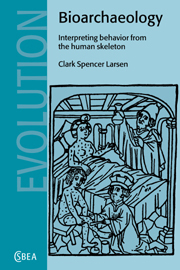Book contents
- Frontmatter
- Contents
- Acknowledgments
- 1 Introduction
- 2 Stress and deprivation during the years of growth and development and adulthood
- 3 Exposure to infectious pathogens
- 4 Injury and violent death
- 5 Activity patterns: 1. Articular and muscular modifications
- 6 Activity patterns: 2. Structural adaptation
- 7 Masticatory and nonmasticatory functions: craniofacial adaptation
- 8 Isotopic and elemental signatures of diet and nutrition
- 9 Historical dimensions of skeletal variation: tracing genetic relationships
- 10 Changes and challenges in bioarchaeology
- References
- General index
- Site index
2 - Stress and deprivation during the years of growth and development and adulthood
Published online by Cambridge University Press: 05 June 2012
- Frontmatter
- Contents
- Acknowledgments
- 1 Introduction
- 2 Stress and deprivation during the years of growth and development and adulthood
- 3 Exposure to infectious pathogens
- 4 Injury and violent death
- 5 Activity patterns: 1. Articular and muscular modifications
- 6 Activity patterns: 2. Structural adaptation
- 7 Masticatory and nonmasticatory functions: craniofacial adaptation
- 8 Isotopic and elemental signatures of diet and nutrition
- 9 Historical dimensions of skeletal variation: tracing genetic relationships
- 10 Changes and challenges in bioarchaeology
- References
- General index
- Site index
Summary
Introduction
Physiological disruption resulting from impoverished environmental circumstances – ‘stress’ – is central to the study of health and well-being and the reconstruction of adaptation and behavior in earlier and contemporary human societies (Goodman et al., 1988; Huss-Ashmore et al., 1982). Stress is a product of three key factors, including (1) environmental constraints; (2) cultural systems; and (3) host resistance. Goodman and coworkers (Goodman, 1991; Goodman & Armelagos, 1989; Goodman et al., 1984, 1988) have modeled the interaction of these factors at both the individual and the population levels (Figure 2.1). This model emphasizes the environment in providing both the resources necessary for survival and the stressors that may affect the health of the population. Cultural systems serve as protective buffers, and they provide behaviors necessary for extraction of important nutrients and resources from the environment. All stressors can never be fully buffered; some slip through the filter of the cultural system. In these instances, the individual may exhibit a biological stress response observable at the tissue level (bones and teeth). Physiological disruption feeds directly back into environmental constraints and cultural systems. This model makes clear that health is a key variable in the adaptive process.
- Type
- Chapter
- Information
- BioarchaeologyInterpreting Behavior from the Human Skeleton, pp. 6 - 63Publisher: Cambridge University PressPrint publication year: 1997
- 3
- Cited by



